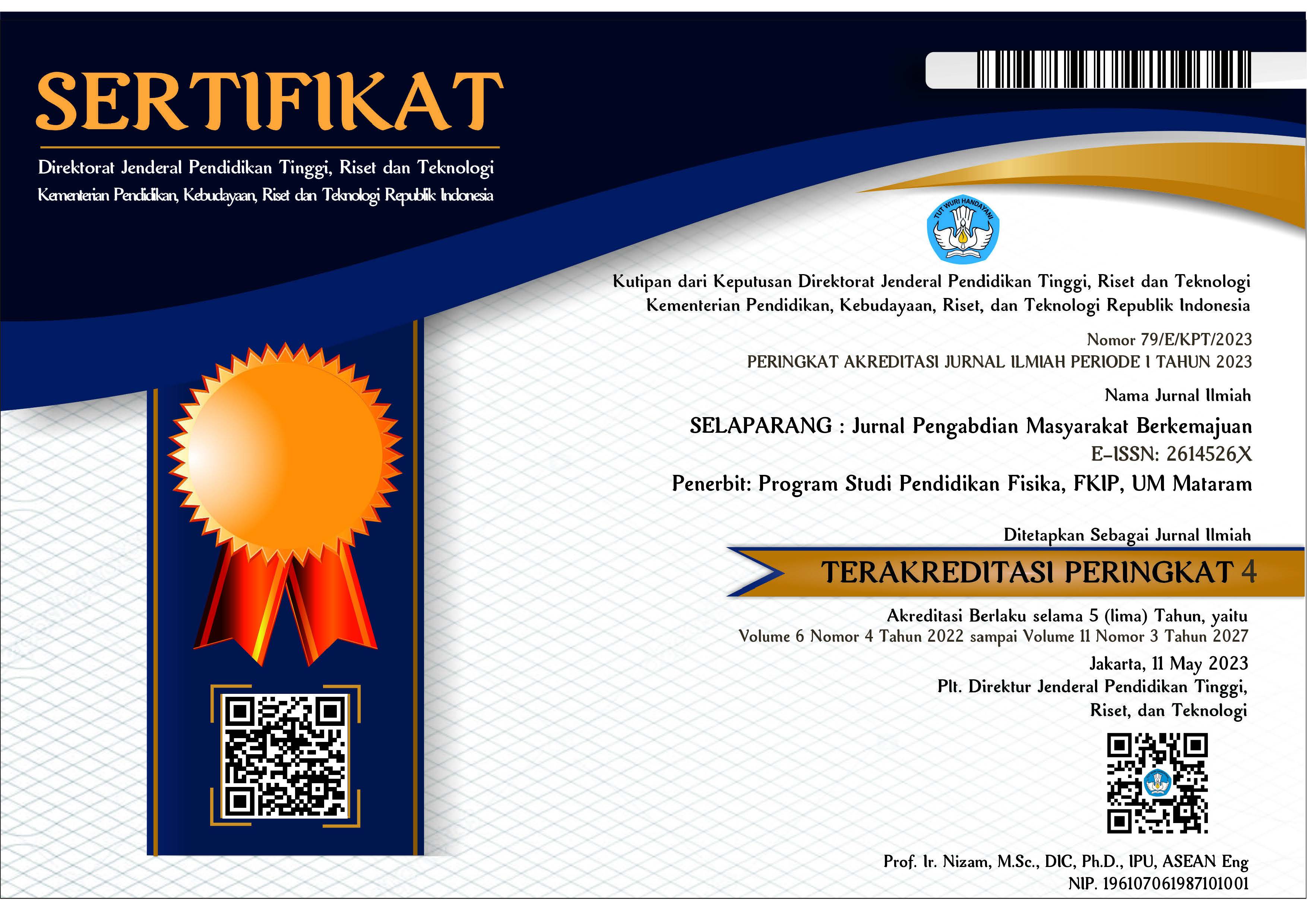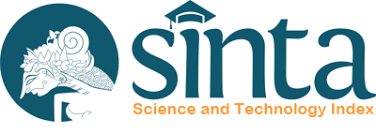Inovasi pengharum ruangan sustainable: pelatihan lilin aromaterapi dan soy wax sachet di Rusunawa Rorotan
Abstract
Abstrak
Aromaterapi merupakan terapi pelengkap yang memanfaatkan minyak atsiri dari tanaman beraroma yang mudah menguap dan memberikan efek relaksasi serta manfaat kesehatan. Rusunawa Rorotan memiliki unit hunian terbatas sekitar 30 m², sehingga warga memerlukan kegiatan yang dapat menghilangkan kejenuhan sekaligus meningkatkan keterampilan. Tujuan utama kegiatan ini meliputi peningkatan pemahaman, penerapan gaya hiudp berkelanjutan, pengembangan keterampilan kreatif, penciptaan peluang ekonomi mikro, serta peningkatan kesejahteraan psikologis melalui stimulus olfaktori dan visual. Kegiatan meliputi registrasi, penyampaian materi, praktik pembuatan produk, serta evaluasi melalui pre dan post test. Hasil evaluasi menunjukkan peningkatan signifikan dalam pengetahuan peserta, terlihat dari nilai rata-rata pre-test dan post-test yang berturut-turut mencapai 65,8 dan 82,57, serta respons positif peserta terhadap produk yang mudah dibuat (100%), bentuk produk menarik (74%), dan memiliki aroma wangi (67%) yang berdampak pada peningkatan mood. Kesimpulan dari kegiatan ini, secara keseluruhan pelatihan aromaterapi tidak hanya mengurangi kejenuhan di lingkungan padat, tetapi juga mendorong transformasi kearifan lokal menjadi solusi kreatif dna berkelanjutan secara ekonomi bagi warga Rusunawa Rorotan.
Kata kunci: aromaterapi; dekoratif; essential oil; sustainable.
Abstract
Aromatherapy is a complementary therapy that utilizes essential oils from aromatic plants, which are volatile and provide relaxation and helath benefits. Rusunawa Rorotan has limited living units of approximately and health benefits. Rusunawa Rorotan has limited living units of approximately 30 m², residents face challenges related to psychological well-being and limited opportunities for skill development. This community-based training program aimed to enhance participants’ understanding of sustainable lifestyles, promote the practical application of aromatherapy, foster creative skills, generate microeconomic opportunities, and improve psychological well-being through olfactory and visual stimuli. The program consisted of registration, theoretical sessions, hands-on product-making workshops, and evaluation via pre- and post-tests. Results indicated a significant improvement in participants’ knowledge, with average pre-test and post-test scores rising from 65.8 to 82.57, respectively. Furthermore, participant feedback revealed that 100% found the products easy to make, 74% appreciated the attractive design, and 67% noted pleasant aromas that positively influenced mood. In conclusion, the aromatherapy training effectively alleviated mental fatigue in a densely populated environment and successfully transformed local traditional knowledge into innovative, sustainable, and economically viable solutions for the community of Rusunawa Rorotan.
Keywords: aromatherahy; decorative; essential oil; sustainable.
Keywords
Full Text:
PDFReferences
Baccarani, A., Brand, G., Dacremont, C., Valentin, D., & Brochard, R. (2021). The influence of stimulus concentration and odor intensity on relaxing and stimulating perceived properties of odors. Food Quality and Preference, 87. https://doi.org/https://doi.org/10.1016/j.foodqual.2020.104030
Carlos Alberto Ruggerio. (2021). Sustainability and sustainable development: A review of principles and definitions. Science of The Total Environment, 786, 147481. https://doi.org/https://doi.org/10.1016/j.scitotenv.2021.147481
Cui, J., Li, M., Wei, Y., Li, H., He, X., Yang, Q., Li, Z., Duan, J., Wu, Z., Chen, Q., Chen, B., Li, G., Ming, X., Xiong, L., & Qin, D. (2022). Inhalation Aromatherapy via Brain-Targeted Nasal Delivery: Natural Volatiles or Essential Oils on Mood Disorders. Frontiers in Pharmacology, 13(April), 1–15. https://doi.org/10.3389/fphar.2022.860043
Gupta, S. P. (2020). Statistical Methods. Sultan Chnad and Sons.
Howell, D. C. (2016). Fundamental Statistics for the Behavioral Sciences 9th Edition. Cengage Learning.
Klimek-szczykutowicz, M., Szopa, A., & Ekiert, H. (2020). Citrus limon (Lemon) phenomenon—a review of the chemistry, pharmacological properties, applications in the modern pharmaceutical, food, and cosmetics industries, and biotechnological studies. Plants, 9(1). https://doi.org/10.3390/plants9010119
Kumar, S., Mahapatro, G. K., Yadav, D. K., Tripathi, K., Koli, P., Kaushik, P., Sharma, K., & Nebapure, S. (2022). Essential oils as green pesticides: An overview. Indian Journal of Agricultural Sciences, 92(11), 1298–1305. https://doi.org/10.56093/ijas.v92i11.122746
Lestari, D., Vidayanti, E., & Jumari, A. (2020). Lilin Aromaterapi dari Minyak Atsiri Kulit Jeruk Manis (Citrus sinensis). Equilibrium Journal of Chemical Engineering, 3(2), 69. https://doi.org/10.20961/equilibrium.v3i2.43098
Melviani, M., Nastiti, K., & Noval, N. (2021). Pembuatan Lilin Aromaterapi Untuk Meningkatkan Kreativitas Komunitas Pecinta Alam Di Kabupaten Batola. RESWARA: Jurnal Pengabdian Kepada Masyarakat, 2(2), 300–306. https://doi.org/10.46576/rjpkm.v2i2.1112
Pham, H. D., Pham, T. N., Nga, D. T. K., Nhung, N. T. T., Lam, T. D., & Toan, T. Q. (2020). Preparation and characterization of naturally scented candles using the lemongrass (Cymbopogon citratus) essential oil. In Materials Science Forum, 977, 212–217.
Putri, C., & Sari, M. (2024). Pemberdayaan Generasi Muda Melalui Produksi Kerajinan Tangan Berbasis Kearifan Lokal. 3(2), 1–7.
Reddy, K. P., Chandu, V., Srilakshmi, S., Thagaram, E., Sahyaja, C., & Osei, B. (2023). Consumers perception on green marketing towards eco-friendly fast moving consumer goods. International Journal of Engineering Business Management, 15, 1–14. https://doi.org/10.1177/18479790231170962
Spence, C. (2020). Using Ambient Scent to Enhance Well-Being in the Multisensory Built Environment. Frontiers in Psychology, 11(November), 1–19. https://doi.org/10.3389/fpsyg.2020.598859
Tabatabaeichehr, M., & Mortazavi, H. (2020). The Effectiveness of Aromatherapy in the Management of Labor Pain and Anxiety: A Systematic Review. Ethiopian Journal of Health Sciences, 30(3), 449–458. https://doi.org/10.4314/ejhs.v30i3.16
Vora, L. K., Gholap, A. D., Hatvate, N. T., Naren, P., Khan, S., Chavda, V. P., Balar, P. C., Gandhi, J., & Khatri, D. K. (2024). Essential oils for clinical aromatherapy: A comprehensive review. Journal of Ethnopharmacology, 330(March), 118180. https://doi.org/10.1016/j.jep.2024.118180
DOI: https://doi.org/10.31764/jpmb.v9i5.30886
Refbacks
- There are currently no refbacks.

This work is licensed under a Creative Commons Attribution-ShareAlike 4.0 International License.
______________________________________________________
Jurnal Selaparang
p-ISSN 2614-5251 || e-ISSN 2614-526X
EDITORIAL OFFICE:



















